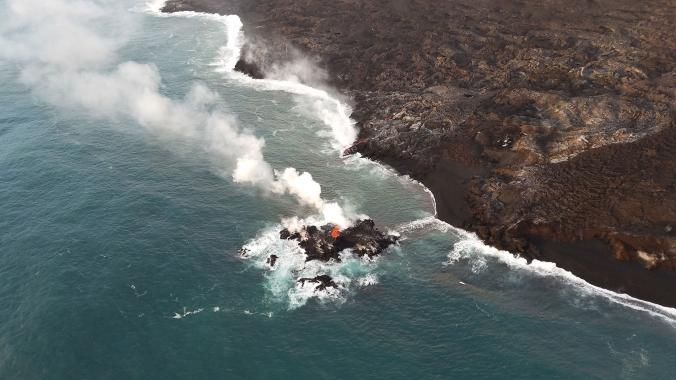
The Kilauea eruption briefly formed this small island off the coast of Hawaii.
Last week, the ongoing Kilauea eruption spawned a tiny addition to the Hawaiian island chain. A little baby islet, only about 20 or 30 feet from edge to edge, popped up off the coast of the Big Island—seemingly ready to strike out on its own adventure in the wide blue Pacific.
But the islet didn’t last long. Only a few days later, a fresh pump of lava filled in a track between the coast and the baby isle, turning it into isthmus instead.
The island’s brief existence is only the latest entry in a serial drama: the millions-year-long origin sto
The first glimmer of the very first Hawaiian island poked up out of the ocean floor over 60 million years ago. A fountain of hot melted rock—magma—from deep in the mantle, streamed upward until lava bubbled up into the sea. The new mound of hot rock kept growing a few inches taller each year until, after 50,000 or 100,000 years, it breached the surface of the Pacific Ocean. Et voilà, an island was born.
The magma comes from a “hot spot” deep in Earth’s mantle. The hot spot seems to be fixed in place, percolating like a constantly boiling kettle that provides a steady supply of magma coursing upward toward Earth’s surface.
But the tectonic plate that sits on top of the mantle drifts slowly on geologic timescales—currently, it’s moving a few inches northwest every year. As it drifts, it drags the islands far enough away that they’re cut off from the magma source below. At that point, the volcanoes on those islands go extinct.
The older islands of Hawaii—like Kauai and Ni’ihau—used to sit where Kilauea is today about five million years ago. The oldest islands in the long archipelago (at least, the ones that are still above the water’s surface), about 3,000 miles to the northwest, were born about 60 million years ago.
The island of Hawaii is the youngest in the Hawaiian chain—at least, of those above the waves. Lo’ihi, an island-in-progress growing off the southern shore of the Big Island, is currently underwater and should emerge in about ten thousand years.
The Big Island was built by five different volcanoes. Two of those volcanoes have shifted far enough from the magma source that they’ve gone extinct, leaving three that are currently active: Mauna Loa, which last erupted in 1984; Hualalai, which last erupted in 1801; and the current center of attention, Kilauea.
BY

Leave a Reply